 WotC revealed the new keywords in Eldritch Moon Monday and you've been very patient as I've slowly built up to reviewing Meld from a Design perspective. There are lots of strong feelings about this mechanic, and rightly so.
WotC revealed the new keywords in Eldritch Moon Monday and you've been very patient as I've slowly built up to reviewing Meld from a Design perspective. There are lots of strong feelings about this mechanic, and rightly so.Official spoilers follow, but no custom cards do.
Merge is the love-child of B.F.M. and double-faced cards. Maro explained how DFCs solved the black-bordered issues with two-card creatures and we can all agree it's a clever solution. A solution that Chah found in 2011 and that the Tesla team followed for several years before putting on the afterburner. That's why we're extra excited to see this mechanic coming to real cardstock.
There are three pairs of these cards that merge together in Eldritch Moon. It seems a bit cruel to only give us three, but it makes sense: First, merge is radically new and WotC needs to be a bit cautious with mechanics that could backfire with the audience; second, we're still on Innistrad, so the majority of our DFCs still need to be werewolves; and third each merge creature costs not just two card slots, but two DFC card slots, so they're expensive in terms of space in the card file.
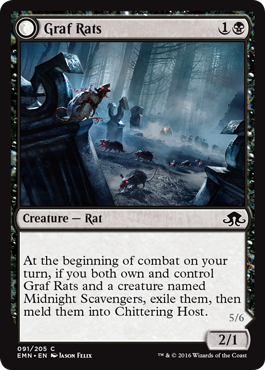 If the DFC slots are so crowded, why introduce merge here? For a set to include DFCs at all is a commitment that requires a lot of work for multiple departments. Combine that with the need for caution I just mentioned, and it would be risky to introduce merge in another set that has no other DFCs. By introducing a few here—where the flavor is creepy and awesome—they can gauge whether to try and fill a set with more of them later on.
If the DFC slots are so crowded, why introduce merge here? For a set to include DFCs at all is a commitment that requires a lot of work for multiple departments. Combine that with the need for caution I just mentioned, and it would be risky to introduce merge in another set that has no other DFCs. By introducing a few here—where the flavor is creepy and awesome—they can gauge whether to try and fill a set with more of them later on.Which is one reason they paired specific creatures rather than keeping the cards modular like GA did. With only 6 faces, the variation gained by making them modular (from 3 monsters to 9) wasn't significant compared to the simplicity of pre-determined backs (both from a player comprehension standpoint, and from a development standpoint) or the flavor or the visual impact of a huge card with the same aspect ratio. Keeping it simple also gives them room to grow and continue to wow us later with more modular tech, while guiding the audience along stepping stones of understanding: Modular mergers will be easier to figure out for players who first saw these simpler mergers.
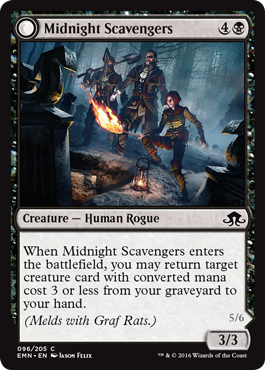 There were a lot of technical and practical considerations that went into this implementation. What happens when a two-card creature dies, or changes zones some other way? Both cards go to the same zone (in the order of their owner's choosing). The same solution we landed on. But that explains the awkward "own and control" phrasing: I can't put your cards in my library or graveyard, so if the cards go to the same zone, I have to own both of them. And obviously it would suck if I used my Graf Rats to steal back the Midnight Scavengers you paid {3}{U}{U} and a card to take from me.
There were a lot of technical and practical considerations that went into this implementation. What happens when a two-card creature dies, or changes zones some other way? Both cards go to the same zone (in the order of their owner's choosing). The same solution we landed on. But that explains the awkward "own and control" phrasing: I can't put your cards in my library or graveyard, so if the cards go to the same zone, I have to own both of them. And obviously it would suck if I used my Graf Rats to steal back the Midnight Scavengers you paid {3}{U}{U} and a card to take from me.The process of merging first exiles both creatures, which eliminates a big question whether the new monster starts tapped or not, especially when half of it was tapped and the other wasn't. But it also handles auras and counters: They all fall off. That might not be maximal fun, but preserving clarity is important with a mechanic as weird as this.
Meld is an action word and it only addresses the act of turning two meldable cards over and making them a single creature/card. The exile, the "own and control"—while consistent everywhere it appears in Eldritch Moon—are not baked into that keyword. Neither is the trigger, which varies on all three cards. Maybe R&D is testing out those three modes to see which one is best received in case they do return to meld someday. It's sufficient explanation that they don't want the only three meld cards to play too similarly, though. It's possible all of that was left out of meld so that 'meld' could refer only to the awesome, terrifying flavorful part but it's also possible that they've already mapped out other uses for meld that don't work the same way. At the very least, it would be trivial (as far as the front face is concerned) to meld one card with a subset of other cards rather than one specific card.
The biggest concern we Artisans found when exploring this mechanic in terms of gameplay, not complexity or technicalities, was the danger of card disadvantage. When you combine two creatures into a single card, they both die to Doom Blade, and that's even worse than casting an aura and losing both it and your target to sudden removal. Most of our solutions involved giving you back one of the front-face creatures or putting card advantage on the monster side.
Wizards chose to address this problem in the design of each individual front-face pair, rather than at the mechanical level, giving them extra control and variation. Even better, they managed to solve a second problem (inherent to the cardname-meld they're using) with the same solution: Having both halves of the pair in your Limited deck is tricky enough; drawing both in the same game is trickier; but having them both in play at the same time is the trickiest. Both Midnight Scavengers and Bruna, the Fading Light can retrieve their cheaper compatriot from your graveyard. Hanweir Battlements can't do that, but it's less likely to leave play because it's a land.
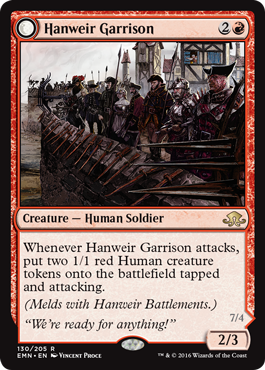 Let's talk about the monsters that are created. Brisela, Voice of Nightmares combines all the keywords of Bruna and Gisela, and adds a new angel-rule ability; Its combined P/T is the sum of the faces'. The Writhing Township upgrades Hanweir Garrison's token-making ability, and adds trample; Land has no P/T, so it adds an arbitrary +4/+1. Since the Rats and Scavengers are virtual vanillas, Chittering Host adds menace as well as a meld trigger and +0/+2.
Let's talk about the monsters that are created. Brisela, Voice of Nightmares combines all the keywords of Bruna and Gisela, and adds a new angel-rule ability; Its combined P/T is the sum of the faces'. The Writhing Township upgrades Hanweir Garrison's token-making ability, and adds trample; Land has no P/T, so it adds an arbitrary +4/+1. Since the Rats and Scavengers are virtual vanillas, Chittering Host adds menace as well as a meld trigger and +0/+2.I imagine Design would have loved to let all the monsters follow the model A + B + new ability, but quickly found the needs of the front (simple, with some card advantage / pair recursion) and the back (really splashy and flavorful) too disparate to pull that off consistently. And it definitely is important that the monster side rawr and thrash sufficiently—we need a big reward for a hoop that small. This is another potential reason there are only three meld pairs: the design space for them may be quite small. If so, we might not see meld ever again, even if it is popular.
While meld does appear at common, we won't see it happen often at the prerelease. Even a player who puts a Rat and a Scavenger in their deck might never meld them across three or four matches. It'll be more of a rare event, and so it's appropriate—even necessary—that when it does happen the result is pretty spectacular. I know I'll be sad after I bother with checklist cards for a pair of these and never get to meld them, but it helps an awful lot that only one of them is below the curve of what you'd be happy to play in your deck regardless.
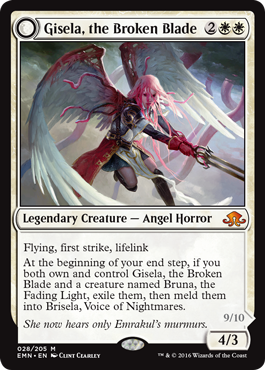 Constructed is where we'll test the power of this mechanic, since it'll be a lot easier to draw one of four Garrisons and one of four Battlements in the same game. Being able to activate meld at the end of your opponents turn—or even in response to removal—helps make that pair pretty viable. As amazing as Gisela is, I have trouble imagining competitive decks bothering with Bruna, but that's fine: That pair serves Timmy and casual formats. Which means our three pairs are serving three of Magic's largest audiences (and that's not counting Mel and Vorthos, who both have reason to enjoy these).
Constructed is where we'll test the power of this mechanic, since it'll be a lot easier to draw one of four Garrisons and one of four Battlements in the same game. Being able to activate meld at the end of your opponents turn—or even in response to removal—helps make that pair pretty viable. As amazing as Gisela is, I have trouble imagining competitive decks bothering with Bruna, but that's fine: That pair serves Timmy and casual formats. Which means our three pairs are serving three of Magic's largest audiences (and that's not counting Mel and Vorthos, who both have reason to enjoy these).I think I've talked myself down from being over-eager to try them, but not because I'm not excited, just because I'll likely need some patience before I get to.

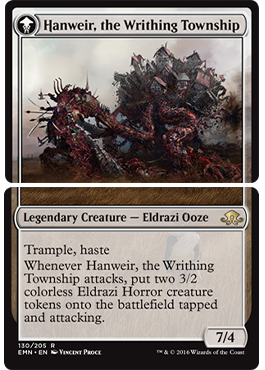
I wish they'd made an uncommon pairing that was below the curve individually and pushed once melded. It would have made for some epic drafting stories.
ReplyDeleteMeld is the kind of thing I would probably hate if it was pitched to me as a concept, but I turn out to love because
ReplyDelete1) it uses DFCs, and I've come around on DFCs
2) it's like Mecha, and since Mecha were the biggest draw for me to the Tesla Project I love that WotC has found an implementation that works in the official game
3) Brisela.
I think meld is a perfectly safe approach to the mechanic. That's not a bad thing, but it is a bit underwhelming. It's also awkward that the most visible meld pair is some generic rat monster. Here's hoping for a bigger implementation next time
ReplyDeleteI would like to make a minor correction to this article: I was the first to suggest the flip-to-combine mechanic on this site. http://goblinartisans.blogspot.jp/2011/12/21-ways-to-design-card-another-use-for.html
ReplyDeleteNot that it matters much though. And it seems Duel Masters had a flip-to-combine mechanic earlier than that.
2011!
DeleteThanks for catching that, Chah, my mistake. Correcting the post.